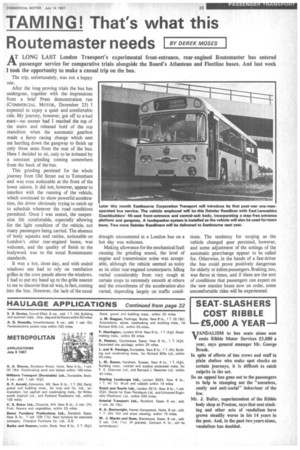TAMING! That's what this Routemaster needs BY DEREK MOSES A T
Page 37

If you've noticed an error in this article please click here to report it so we can fix it.
LONG LAST London Transport's experimental front-entrance, rear-engined Routemaster has entered passenger service for comparative trials alongside the Board's Atlantean and Fleetline buses. And last week I took the opportunity to make a casual trip on the bus. The trip, unfortunately, was not a happy After the long proving trials the bus has undergone, together with the impressions from a brief Press demonstration run (COMMERCIAL MOTOR, December 23) I expected to enjoy a quiet and comfortable ride. My journey, however, got off to a bad start—no sooner had I reached the top or the stairs and released hold of the top stanchion when the automatic gearbox made a fierce racing change •which sent me hurtling down the gangway to finish up only three seats from the rear of the bus. Here I decided to sit, only to be irritated by a constant grinding coming somewhere from the back of the bus.
This grinding persisted for the whole journey from Old Street out to Tottenham and was even noticeable at the front of the lower saloon. It did not, however, appear to interfere with the running of the vehicle, which continued to show powerful acceleration, the driver obviously trying to catch up to schedule whenever the road conditions permitted. Once I was seated, the suspension felt comfortable, especially allowing for the light condition of the vehicle, not many passengers being carried. The absence of body squeaks and rattles, noticeable on London's other rear-engined buses, was welcome, and the quality of finish to the bodywork was to the usual Routemaster standards.
It was a hot, close day, and with sealed windows one had to rely on ventilation grilles in the cove panels above the windows.
I had to put my hand up to the grille nearest to me to discover that air was, in fact, coming into the bus. However, the lack of the usual draught encountered in a London bus on a hot day was welcome.
Making allowance for the mechanical fault causing the grinding sound, the level of engine and transmission noise was acceptable, although the vehicle seemed as noisy as its other rear-engined counterparts. Idling varied considerably from very rough at certain stops to extremely smooth at others and the smoothness of the acceleration also varied, depending largely on traffic condi tions. The tendency for surging as the vehicle changed gear persisted, however, and some adjustment of the settings of the automatic gearchange appear to be called for. Otherwise, in the hands of a fast driver the bus could prove positively dangerous for elderly or infirm passengers. Braking, too, was fierce at times, and if these are the sort of conditions that passengers can expect on the new standee buses now on order, some uncomfortable rides will be experienced.


























































































































